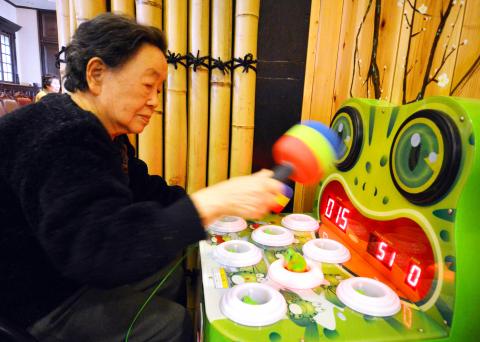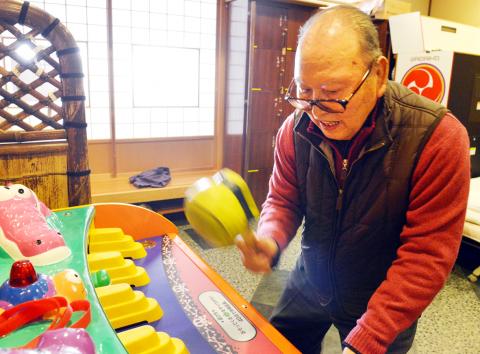At a nursing home in suburban Tokyo, 88-year-old Saburo Sakamoto darts his fingers energetically to catch characters that appear on a touch screen in front of him.
Peals of laughter erupt from the other side of the room full of octogenarians as they wallop plastic alligators that appear from little holes or wield foam hammers to crush frogs as they pop up.
“The ladies here are very agile, so it’s almost impossible for me to beat them,” says Sakamoto as he catches his breath and watches several women easily outscore him on the game he is playing. The nursing home is run by an offshoot of Namco Bandai, the company behind 1980s arcade phenomenon PacMan, whose pill-popping escapades helped bring video games to a mass youth market.

Photo: AFP
Now the firm is part of a small, but growing band of groups developing video games and home computer entertainment for the so-called “silver generation” — Japan’s burgeoning army of elderly people, who are living longer and healthier lives than ever before.
Japan’s population has been declining since 2007 and the country is greying, with one of the world’s lowest birth rates and highest life expectancies.
“We offer entertainment so that elderly people spend the whole day playing, having fun, and getting really exhausted before returning to their home,” said Yoshiaki Kawamura, President of Kaikaya Ltd, the wholly-owned unit of Namco Bandai Holdings.

Photo: AFP
Day visitors, whose average age is 85, have a choice of activities at this government approved center, including assisted bathing, physiotherapy, lunch and a series of arcade and video games.
“The video games are very much extra-curricular, voluntary activities ... but clients look very animated when they are playing,” Kawamura said.
GAMES FOR THE SOUL
Facility staff try to motivate the elderly, tapping into their competitive spirits by posting leader boards on the walls and running competitions to see who is the “most vigorous” every few months.
Among the titles on offer is Dokidoki Hebi Taiji II (Thrilling Snakebuster II), a game developed by Namco Bandai in cooperation with Kyushu University Hospital in western Japan.
Like a life-size version of Whack-a-Mole, a seated player stamps on cartoon-like snakes that pop up at random around him.
Developers say the motion strengthens legs and hip muscles, something doctors say is important to help prevent falls.
It also increases cerebral blood flows especially to the frontal lobe, which may help to slow the progress of cognitive impairment, says Kyushu University doctor Shinichiro Takasugi.
In practice, “it is hard to get scientific proof of a particular game’s positive effect because of factors from other exercises,” said Kaikaya’s musculoskeletal nurse Miyuki Takahashi.
“But the psychological effect is unarguable — people’s faces light up when they play it.”
Takasugi agrees that there are clearly mood-enhancing benefits to be had.
“The game is an effective tool to lighten up the souls of elderly people who tend to stay at home, withdrawing from social life,” he said.
“It can also help keep them engaged with what can be boring rehab exercises.”
LET’S GET PHYSICAL
Where video games have historically been sedentary and solitary, improving technology means controlling characters on a screen no longer needs to be done just by hitting keys or wobbling a joystick.
The same kit that allows young gamers to kick and punch their way through a beat-em-up is now being used to liven up monotonous rehabilitation.
Using the Kinect motion sensor — developed by Microsoft for its video game console Xbox — Physical therapist Keizo Sato worked with two companies to devise game software specifically to help boost strength and suppleness.
Rehact — a contraction of the English words “rehabilitation” and “active” — is intended to provide high-quality exercises for elderly people who might live in rural areas away from specialized medical facilities.
“The scarcity of people who can provide rehab training to elderly people in smaller cities and the cost of it are challenges for ageing Japan,” said Sato, who lectures at Tohoku Fukushi University.
There are four games to choose from, each aimed at specific muscle groups, said Sato.
“But this software not only offers motivation to help people enjoy the exercises, but demonstrates the correct way to do them without the need for a therapist to be present,” he said.
Osaka-based Medica Shuppan Publisher last year released a similar game machine co-developed by Kyushu University researchers, while the same researchers are developing another one in a three-year program funded by the government.
And Nintendo, the maker of the Donkey Kong and Super Mario franchises, said late January it aims to reboot its business by entering the health care industry with “non-wearable” products.
No details have been made available on what this means, but the Kyoto-based leading game console maker already offers fitness game software Wii Fit series.
“I think these so-called ‘exergames’ will be a powerful tool for curbing snowballing medical costs in Japan,” said Sato.

May 11 to May 18 The original Taichung Railway Station was long thought to have been completely razed. Opening on May 15, 1905, the one-story wooden structure soon outgrew its purpose and was replaced in 1917 by a grandiose, Western-style station. During construction on the third-generation station in 2017, workers discovered the service pit for the original station’s locomotive depot. A year later, a small wooden building on site was determined by historians to be the first stationmaster’s office, built around 1908. With these findings, the Taichung Railway Station Cultural Park now boasts that it has

Wooden houses wedged between concrete, crumbling brick facades with roofs gaping to the sky, and tiled art deco buildings down narrow alleyways: Taichung Central District’s (中區) aging architecture reveals both the allure and reality of the old downtown. From Indigenous settlement to capital under Qing Dynasty rule through to Japanese colonization, Taichung’s Central District holds a long and layered history. The bygone beauty of its streets once earned it the nickname “Little Kyoto.” Since the late eighties, however, the shifting of economic and government centers westward signaled a gradual decline in the area’s evolving fortunes. With the regeneration of the once

The latest Formosa poll released at the end of last month shows confidence in President William Lai (賴清德) plunged 8.1 percent, while satisfaction with the Lai administration fared worse with a drop of 8.5 percent. Those lacking confidence in Lai jumped by 6 percent and dissatisfaction in his administration spiked up 6.7 percent. Confidence in Lai is still strong at 48.6 percent, compared to 43 percent lacking confidence — but this is his worst result overall since he took office. For the first time, dissatisfaction with his administration surpassed satisfaction, 47.3 to 47.1 percent. Though statistically a tie, for most

In February of this year the Taipei Times reported on the visit of Lienchiang County Commissioner Wang Chung-ming (王忠銘) of the Chinese Nationalist Party (KMT) and a delegation to a lantern festival in Fuzhou’s Mawei District in Fujian Province. “Today, Mawei and Matsu jointly marked the lantern festival,” Wang was quoted as saying, adding that both sides “being of one people,” is a cause for joy. Wang was passing around a common claim of officials of the People’s Republic of China (PRC) and the PRC’s allies and supporters in Taiwan — KMT and the Taiwan People’s Party — and elsewhere: Taiwan and